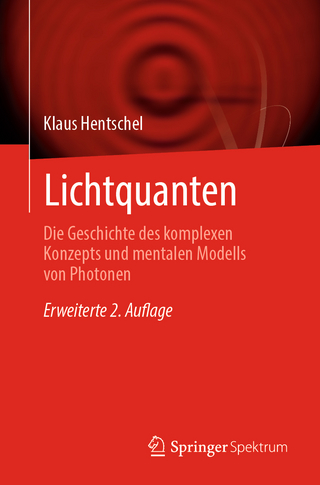
Primer for Point and Space Groups
Springer-Verlag New York Inc.
978-0-387-40248-2 (ISBN)
1 Groups and Subgroups.- 1.1 Definitions and Basics.- 1.2 Group Table.- 1.3 Rearrangement Theorem.- 1.4 Building Groups. Subgroups.- Summary of Topics for Chapter 1.- Problems.- 2 Classes and Platonic Solids.- 2.1 Conjugate Elements.- 2.2 Classes.- 2.3 Direct Product.- 2.4 Cnv and Dn Groups.- 2.5 Platonic Solids. T, O and I Groups.- Summary of Topics for Chapter 2.- Problems.- 3 Matrices, Irreps and the Great Orthogonality Theorem.- 3.1 Matrix Representations of Operators.- 3.2 Irreducible Representations.- 3.3 Great Orthogonality Theorem (GOT).- 3.4 Six Important Rules.- 3.5 Character Tables. Bases.- 3.6 Representations of Cyclic Groups.- Summary of Topics for Chapter 3.- Problems.- 4 Quantum Mechanics, the Full Rotation Group, and Young Diagrams.- 4.1 Application to Quantum Mechanics.- 4.2 Full Rotation Group O(3).- 4.3 SU(2).- 4.4 Irreps of O(3)+ and Coupled Angular Momentum States.- 4.5 Symmetric Group; Cayley’s Theorem.- 4.6 Young Diagrams.- 4.7 Degenerate Perturbation Theory.- Summary of Topics for Chapter 4.- Problems.- 5 Space Groups, Brillouin Zone and the Group of k.- 5.1 Cosets and Invariant Subgroups. The Factor Group.- 5.2 Primitive Vectors. Braviais Lattice. Reciprocal Lattice Space.- 5.3 Crystallographic Point Groups and Reciprocal Lattice Space.- 5.4 Bloch Waves and Space Groups.- 5.5 Application to Semiconductor Materials.- 5.6 Time Reversal, Space Inversion and Double Space Groups.- Summary of Topics for Chapter 5.- Problems.- 6 Atoms in Crystals and Correlation Diagrams.- 6.1 Central-Field Approximation.- 6.2 Atoms in Crystal Fields.- 6.3 Correlation Diagrams.- 6.4 Electric and Magnetic Material Properties.- 6.5 Tensors in Group Theory.- Summary of Topics for Chapter 6.- Problems.- 7 Elements of Abstract Algebra and the Galois Group.- 7.1 IntegralDomains, Rings and Fields.- 7.2 Numbers.- 7.3 Irreducible Polynomials.- 7.4 The Galois Group.- Symbols for Chapter 7.- Summary of Topics for Chapter 7.- Problems.- Appendix A: Character Tables for the Point Groups.- Bibliography of Works in Group Theory and Allied Topics.
| Reihe/Serie | Undergraduate Texts in Contemporary Physics |
|---|---|
| Zusatzinfo | XIV, 220 p. |
| Verlagsort | New York, NY |
| Sprache | englisch |
| Maße | 155 x 235 mm |
| Themenwelt | Naturwissenschaften ► Physik / Astronomie ► Allgemeines / Lexika |
| Technik ► Elektrotechnik / Energietechnik | |
| ISBN-10 | 0-387-40248-9 / 0387402489 |
| ISBN-13 | 978-0-387-40248-2 / 9780387402482 |
| Zustand | Neuware |
| Haben Sie eine Frage zum Produkt? |
aus dem Bereich


